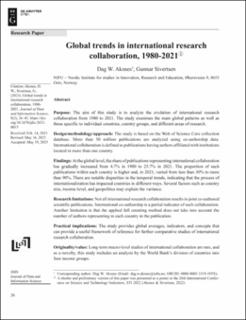| dc.description.abstract | Purpose: The aim of this study is to analyze the evolution of international research collaboration from 1980 to 2021. The study examines the main global patterns as well as those specific to individual countries, country groups, and different areas of research.
Design/methodology/approach: The study is based on the Web of Science Core collection database. More than 50 million publications are analyzed using co-authorship data. International collaboration is defined as publications having authors affiliated with institutions located in more than one country.
Findings: At the global level, the share of publications representing international collaboration has gradually increased from 4.7% in 1980 to 25.7% in 2021. The proportion of such publications within each country is higher and, in 2021, varied from less than 30% to more than 90%. There are notable disparities in the temporal trends, indicating that the process of internationalization has impacted countries in different ways. Several factors such as country size, income level, and geopolitics may explain the variance.
Research limitations: Not all international research collaboration results in joint co-authored scientific publications. International co-authorship is a partial indicator of such collaboration. Another limitation is that the applied full counting method does not take into account the number of authors representing in each country in the publication.
Practical implications: The study provides global averages, indicators, and concepts that can provide a useful framework of reference for further comparative studies of international research collaboration.
Originality/value: Long-term macro-level studies of international collaboration are rare, and as a novelty, this study includes an analysis by the World Bank’s division of countries into four income groups. | |
